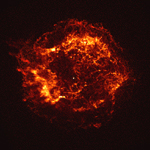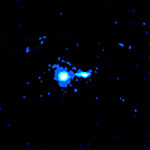August 26, 1999
CXC PR: 99-02
Extraordinary first images from NASA's Chandra X-ray Observatory trace the aftermath of a gigantic stellar explosion in such stunning detail that scientists can see evidence of what may be a neutron star or black hole near the center. Another image shows a powerful X-ray jet blasting 200,000 light years into intergalactic space from a distant quasar.
Released today, both images confirm that NASA's newest Great Observatory is in excellent health and its instruments and optics are performing up to expectations. Chandra, the world's largest and most sensitive X-ray telescope, is still in its orbital check-out and calibration phase.
"When I saw the first image, I knew that the dream had been realized," said Dr. Martin Weisskopf, Chandra Project Scientist, NASA's Marshall Space Flight Center, Huntsville, AL. "This observatory is ready to take its place in the history of spectacular scientific achievements."
"We were astounded by these images," said Harvey Tananbaum, Director of the Smithsonian Astrophysical Observatory's Chandra X- ray Center, Cambridge, MA. "We see the collision of the debris from the exploded star with the matter around it, we see shock waves rushing into interstellar space at millions of miles per hour, and, as a real bonus, we see for the first time a tantalizing bright point near the center of the remnant that could possibly be a collapsed star associated with the outburst."
After the telescope's sunshade door was opened last week, one of the first images taken was of the 320-year-old supernova remnant Cassiopeia A, which astronomers believe was produced by the explosion of a massive star. Material blasted into space from the explosion crashed into surrounding material at 10 million miles per hour. This collision caused violent shock waves, like massive sonic booms, creating a vast 50-million degree bubble of X-ray emitting gas.
Heavy elements in the hot gas produce X-rays of specific energies. Chandra's ability to precisely measure these X-rays tells how much of each element is present. With this information, astronomers can investigate how the elements necessary for life are created and spread throughout the galaxy by exploding stars.
"Chandra will help to confirm one of the most fascinating theories of modern science -- that we came from the stars," said Professor Robert Kirshner of Harvard University. "Its ability to make X-ray images of comparable quality to optical images will have an impact on virtually every area of astronomy."
Chandra also imaged a distant and very luminous quasar -- a single star-like object -- sporting a powerful X-ray jet blasting into space. The quasar radiates with the power of 10 trillion suns, energy which scientists believe comes from a supermassive black hole at its center. Chandra's image, combined with radio telescope observations, should provide insight into the process by which supermassive black holes can produce such cosmic jets.
"Chandra has allowed NASA to seize the opportunity to put the U.S. back in the lead of observational X-ray astronomy," said Dr. Edward Weiler, Associate Administrator of Space Science, NASA Headquarters, Washington, DC. "History teaches us that whenever you develop a telescope 10 times better than what came before, you will revolutionize astronomy. Chandra is poised to do just that."
The Chandra X-ray observatory was named in honor of the late Nobel laureate Subrahmanyan Chandrasekhar. NASA's Marshall Space Flight Center manages the Chandra program. TRW, Inc., Redondo Beach, CA, is the prime contractor for the spacecraft. The Smithsonian's Chandra X-ray Center controls science and flight operations from Cambridge, MA.
Press: Fact SheetThe first Chandra images will be posted to the Internet at:
NASA press releases and other information are available automatically by sending an Internet electronic mail message to domo@hq.nasa.gov. In the body of the message (not the subject line) users should type the words "subscribe press-release" (no quotes). The system will reply with a confirmation via E-mail of each subscription. A second automatic message will include additional information on the service. NASA releases also are available via CompuServe using the command GO NASA. To unsubscribe from this mailing list, address an E-mail message to domo@hq.nasa.gov, leave the subject blank, and type only "unsubscribe press-release" (no quotes) in the body of the message.
MEDIA CONTACTS
Donald Savage
Headquarters, Washington, DC
(Phone: 202/358-1547)
Dave Drachlis
Marshall Space Flight Center, Huntsville, AL
(Phone: 256/544-0034)
Wallace Tucker
Chandra X-ray Observatory Center
(Phone: 617/496-7998)




